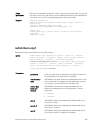Version Description
9.7(0.0) Added supported for VRF. Introduced on the S6000-ON.
9.5(0.1) Introduced on the Z9500.
9.2(0.2) Introduced on the Z9000.
9.0.2.0 Introduced on the S6000.
8.3.19.0 Introduced on the S4820T.
8.3.7.1 Introduced on the S4810.
Usage
Information
The following describes the show isis database command shown in the
following example.
Field Description
IS-IS Level-1/
Level-2 Link State
Database
Displays the IS-IS link state database for Level 1 or Level 2.
LSPID
Displays the LSP identifier.
The first six octets are the System ID of the originating
router.
The first six octets are the System ID of the originating
router. The next octet is the pseudonode ID. If this byte is
not zero, the LSP describes system links. If this byte is zero
(0), the LSP describes the state of the originating router.
The designated router for a LAN creates and floods a
pseudonode LSP and describes the attached systems.
The last octet is the LSP number. An LSP is divided into
multiple LSP fragments if there is more data than cannot fit
in a single LSP. Each fragment has a unique LSP number.
An * after the LSPID indicates that the system originates an
LSP where this command was issued.
LSP Seq Num This value is the sequence number for the LSP that allows
other systems to determine if they have received the latest
information from the source.
LSP Checksum This is the checksum of the entire LSP packet.
LSP Holdtime This value is the amount of time, in seconds, that the LSP
remains valid. A zero holdtime indicates that this is a purged
LSP and is being removed from the link state database. A
value between brackets indicates the duration that the
purged LSP stays in the database before being removed.
Intermediate System to Intermediate System (IS-IS)
1083


















